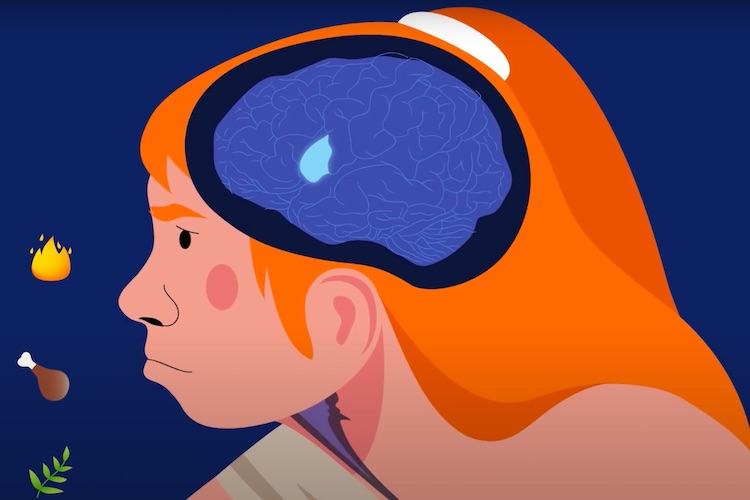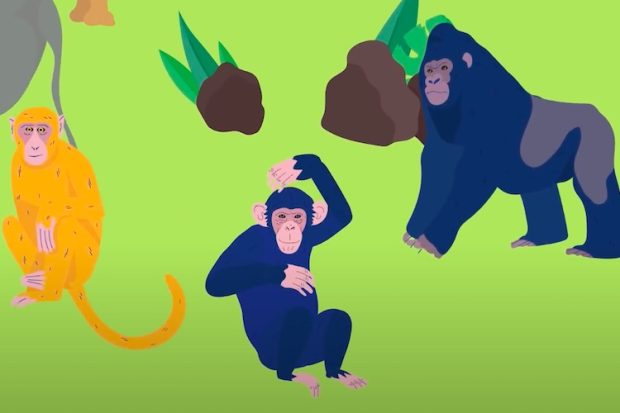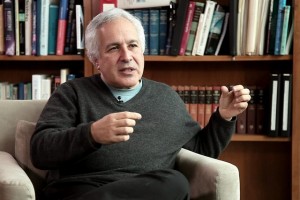Mutations in Humans
Evolutionary biologist Armand Leroi on the ways to understand the functions of all human genes, Cyclopia or ho...

The Neanderthals are a prehistoric human species. They are controversial because they overlap with us in time and show behavior thought to indicate humanity. They share a common ancestor with us, sometime around 600 000 years, the evidence of DNA. This common ancestor is not yet proven but is probably a form of Homo heidelbergensis. When Neanderthals were first discovered, it was thought that they were a direct ancestor of us, but this is not the case. They lived in developed form from c. 250 000 years ago until 30 000 years ago. They developed their ‘classic’ form with large noses and brow ridges, projecting faces, and marked robusticity in the later part of this date range. They were, on average, shorter than modern humans but notably heavily built. It has been argued that they were cold-adapted and had foreshortened forearms and calves to reduce heat loss through circulation. It has also been suggested that their leg proportions may be an adaptation to living in rocky terrain. Their brain sizes were on average similar to or even slightly larger than modern humans. Whether the brain was organized in the same way or was as densely packed with neurons as modern humans is a subject for debate. Neanderthals are found across Eurasia but not in Africa; evidence for them has been found as far west as Portugal and Wales and as far east as Siberia. They ranged from the northern shores of the Mediterranean and were settled in the Middle East. Which part of this range was their place of origin is unclear.

They were discovered in a cave in Germany in 1856, and they derived their name from this cave in the Neander Valley. Although a skull was found ten years earlier in Gibraltar, it was not recognized as different from modern humans. They were first thought to be an aberrant or injured form of a person. Someone even suggested the skeleton was that of a cavalryman from the Napoleonic war because of the curved thigh bones. Later more skeletons were found with the same form in France, Belgium, and Italy, and this confirmed they were a new form of ancient human.
We use a range of archaeological and anthropological techniques to study Neanderthals. The archaeological study demonstrates which artifacts they made, how they were made, and where the raw materials used came from. It provides associations with animal, and plant remains to show diet and the environments in which Neanderthals lived. Excavation can show evidence for Neanderthal constructions; mostly, these are well-made hearths, but stake holes for structures have been found, and recently, an arrangement made up of stalactites and stalagmites has been found, which suggests some form of ‘ritual’ behavior. It has been suggested that Neanderthals placed cave bear skulls in special places in caves as a form of religious expression, but this is questioned. Most importantly, it also recovers materials that can be dated so we know when Neanderthals were present.

Measurements of the bones can help tell us about stature, features of the pelvis and skull, about the sex of the individual, and studying the skeleton overall can show evidence of diseases and injuries. For example, Neanderthals show a range of bone damage that suggests they may have been hurt by close proximity to animals they were hunting. Rounding off the surfaces on their front teeth suggests they used them to soften hides by chewing them. Young Neanderthals show similar patterns of wear and tear as older ones suggesting that Neanderthal children adopted adult roles much sooner than children today. A study of wear, striations, and pits on the teeth can indicate what Neanderthals were eating. They seem to have had a mostly meat-based diet supplemented by plant foods.
The most exciting techniques used at present relate to DNA which shows breeding relationships and inheritance. Individual genes can be identified, and their action calculated. This work shows that Neanderthals and modern humans interbred, and so questions the degree to which we are different species with different behavior and intellect. DNA studies show that some at least had red hair and that we have genes from them that helped us to adapt to European conditions as we moved in from Africa and Asia.
The DNA evidence mentioned above shows that we had a positive relationship with Neanderthals to the extent that we interbred with them. Modern humans moving into Europe had decorative objects and musical instruments, and it is debated as to whether Neanderthals had them. Someone has even suggested that Neanderthals may have copied modern human jewelry, such as beads but didn’t understand their use in establishing social relationships.
It is a big question as to whether Neanderthals could speak – And some also ask whether the first modern humans spoke rather than gaining language some 100 000 years after we first appeared in Africa. This argument is based on the limited archaeological record for sophisticated culture until about 45 000 years ago. It is likely that some verbal communication was used and that both Neanderthals and modern humans had it. Neanderthals certainly had the gene FOXP2 which is used in modern humans to control speech. Neanderthals passed down their cultural traditions through the generations, and the complexity of these traditions makes it likely that some form of teaching and learning was involved. This may have simply been by demonstration but it is possible that spoken instruction was used. Tool making in traditional societies today is often a social activity, and it is likely that Neanderthals met around their hearths to make tools, cook food and interact socially. Some form of language is likely to have underpinned this.
We must be careful of assuming we were naturally superior to Neanderthals simply because we are still here and they are not. They were well adapted to their habitats for some 200 000 years. Indeed, in the Middle East, it appears that modern humans moved into the area as conditions warmed up some 120 000 years ago but were driven out by Neanderthals as the environment became colder again. So on first contact, there was not much between the two groups. Cold adaptation may have favored the Neanderthals for a while before modern humans learned to adapt to it. Some have argued that we were responsible for Neanderthal extinction through genocide or from the competition with them, but the explanation may be much simpler – that we simply outbred them and, over time, replaced them. Prehistoric populations were small and widely dispersed, and it is likely that groups of both Neanderthals and modern humans occasionally died out. Something simple that ensures the more successful raising of offspring over a long period of time could account for Neanderthal extinction on its own. Both populations were living in conditions that deteriorated over time with dispersed groups and limited resources; keeping a population alive would have been a challenge. There is evidence from the DNA that Neanderthals had a high level of inbreeding which would make them vulnerable to disease and genetic faults. Modern human populations seem to have been larger as they moved into Neanderthal territories which on its own would have given them an advantage. So, in fact, Neanderthals didn’t so much die out as were absorbed into our populations but at a very small scale relative to our respective population sizes.
The Neanderthals are associated with a stone tool tradition known as the Mousterian (after the site of Le Moustier in southwestern France). It is based upon blanks made by knocking off flakes from cores that were often worked all around the edge (disc cores) or sometimes using a technique where the shape of the flake to be removed is pre-shaped on the core prior to removal. This technique is called the Levallois technique (after the site of Levallois in northern France). Neanderthals still occasionally used tool types that had their origin in the ancient past, such as bifacial hand axes, but the majority of their tools were scrapers, knives, points, and various bone, wood, and plant working tools. Neanderthals do not appear to have made sophisticated objects out of bone but did use crude bone fragments sometimes.

In the latter part of their existence in France, Neanderthals were using pendants and other artifacts as part of the Chatelperronian culture. These items are usually associated with modern humans. Some argue this was Neanderthals simply copying modern humans but without full knowledge or understanding of what these objects meant. It is possible, given the overlap in dates, that Neanderthals and modern humans co-exist and use the items together with a full understanding of their purpose. In the Middle East, modern human populations first used the same sort of toolkits as Neanderthals and exploited the same range of game species. It was millennia before modern humans changed their cultures to use blade-based tools and develop items such as beads, needles, pendants, and art objects. Both species were cultural, with traditions passing down through groups, and sometimes it is even possible to identify regional variations of traditions being passed on.
The key debates still discuss what the Neanderthal relationship is with us but also with other human types that were contemporary with them. Work at Denisova Cave in Siberia has recovered Neanderthal remains but also a few fragments of another new species that were only identified by DNA work. This new population, the Denisovans, interacted with Neanderthals, and modern human populations in Southeast Asia and Australasia have DNA obtained from interbreeding with them. The fossil evidence for this new population is extremely limited, and we need to find more material and re-examine finds already made to understand what this new population represents. There is also a lack of fossil material for the period when Neanderthals and our own line were first emerging. DNA evidence can provide us with evidence of links and the timing of separation, but it needs to be incorporated into the fossil and cultural records. There is still a lack of material for the crucial times and places where the division occurred. DNA research has produced many new discoveries, and we now need to find ways to integrate these effectively into the more established approaches of archaeology and anthropology.
We need to understand Neanderthal behavior better. They were clearly capable of planning and organizing their activities over landscapes and periods of time, but just how similar to, or different from, were they to us?
There has been a long debate about Neanderthal burials. Did they bury their dead, and if so, does this show ‘humanity’ and religious feelings? The archaeological evidence shows that in some cases, Neanderthals did bury their dead but not all individuals were buried. Neanderthals buried adult males, females, and children and occasionally seem to have buried items with individuals. Do we see expressions of a belief in an afterlife? A demonstration of care, of the roles or status of individuals? There are many questions yet to be effectively addressed.
We still need to know more about the interaction of Neanderthals with modern humans as the former became extinct. An intelligent human species of c. 200, 000 years duration disappeared, and we need to know how and why that happened. What does that process have to tell us about ourselves? What, if anything, was our involvement in the process, and does it hold any warnings about our behavior or fate?
The biggest mystery still remains – how ‘human’ were the Neanderthals? A major problem is how we identify humanity in ourselves. Once we have done that, can we then find a way of identifying it in the archaeological fragments left to us by Neanderthals? There have been moves to have apes provided with ‘human rights’ in law as they clearly show elements of high cognition, sociability, and self-awareness, so if this is to be found in contemporary apes, why would we deny it to our closest fossil relations? Could we have a meaningful conversation with a Neanderthal?

Evolutionary biologist Armand Leroi on the ways to understand the functions of all human genes, Cyclopia or ho...

Scientists have assessed the contribution of humans as a species to the history of life on Earth

Neurobiologist Jeff Lichtman on brain cell connections, Golgi stain, and big data in neurophysiology